Frequently asked questions
-
How more secure than standard AES-256 encryption?
At least a factor 10 500 more secure. If you want to check go to this website and compute 256! and 65,536!
-
What is factorially more secure?
Big(O) notation provides a scale of complexity. For instance, incrementally more secure, would be more secure by a linear factor.
Some believe that exponentially more secure is the highest level of complexity. Actually, the highest level of complexity is factorially more secure.
An operation on N possible elements has a potential factorial complexity of N! (factorial N). For N=256 that means an increased security of more than 10 500. For 16-bits words or N=65,536 the N! takes over 75 printed pages.How do you create that level of security?
LabCipher achieves that level of security by modifying computer operations with the Finite Lab-Transform (FLT) using n-state inverters.
Who invented the FLT?
The FLT was invented and further developed by Peter Lablans who has obtained US Patents for this inventions.
Peter was inspired to his inventions by Dr. “Gerry” Blaauw, his professor in Digital Computer Design, using Blaauw’s approach in computer implementation development. Dr. Blaauw was one of the three architects in the design of the revolutionary and legendary IBM System/360.Patents are mentioned. Is LabCipher proprietary technology?
Yes it is. You need to purchase the LabCipher application. Or obtain a license.
Is LabCipher an novel cryptographic primitive?
No. LabCipher uses exactly the same data-flows as in existing, proven cryptographic primitives such as AES-256, SHA-256, RSA and others. Certain computer instructions are modified by the FLT, making the outcome entirely unpredictable. LabCipher is thus much more secure (factorially so) than the primitives it is based on.
What does LabCipher include?
LabCipher initially includes FLT AES-256, FLT SHA-256, and FLT VPN. It will be expanded with Secure e-mail, Encrypted Chats, Digital Signatures, Secure Browsers, Private PKI and Streaming Ciphers for Real-time Voice and Video Encryption.
Why do I want LabCipher?
Here are some reasons:
1. AES is over 20 years old. It is not upgradable, until now. It will be broken eventually (that is the Law of Cryptography). You should protect highly confidential data against future breaking by using LabCipher.
2. Public Keyword Infrastructure (PKI) keywords will be broken by Quantum Computers. Your secret keywords will be used by attackers to decrypt your encrypted data. LabCipher is QC resistant.
3. Confidential Computing is the desire to protect internal data that increasingly resides in the Cloud. Internal protection of data makes it opaque to any external attackers. There is no need or desire to apply any public and thus attackable public cryptography, making successful attacks unlikely. LabCipher provides this unique and yet proven cryptography.
4. Lightweight Cryptography in computationally underpowered devices such as in IoT use small parameter security primitives (AES-128). LabCipher further lowers the size of parameters while increasing the level of security.
5. The FLT revives previously broken and now considered “not secure” or “almost secure” cryptographic primitives. Some of these are ultra-small and ultra-fast and can now be re-introduced as highly secure by modification with the FLT.Does LabCipher work?
Yes it does. The FLT has been applied in many different computer languages, including Magma, Matlab, Sagemath, VBA and Python. Some LabCipher applications are already created in FLTed standard SHA-256 and AES-256 Python implementations.
FLTed streaming ciphers have been implemented for voice in Matlab.
It all works beautifully.What is the status of LabCipher?
The LabCipher Platform is under development. We are currently fundraising to accelerate the development process.
Can you provide an example of how LabCipher works?
The effect of the FLT is something similar as what is generated by for instance SHA-256. Just different and more unpredictable.
Here are some results of hashing with SHA-256 as one may check at online SHA256 and an FLTed SHA256:
Text: hello world
SHA256: b94d27b9934d3e08a52e52d7da7dabfac484efe37a5380ee9088f7ace2efcde9
FLT: 1750e7aaf616e3e795748bb0f7bd06ebee68fcf51d7d7c1a7b496de92babb4f3
Any different FLT will generate a different hash. All with excellent collision, pre-image and second pre-image security.Who to contact if I want to know more?

Copyright © 2022 All rights reserved.
